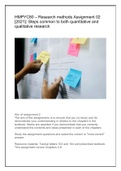HMPYC80 – Research methods Assignment 02
[2021]: Steps common to both quantitative and
qualitative research
Aim of assignment 2
The aim of the assignments is to ensure that you (a) study and (b)
demonstrate your understanding in relation to the chapters in the
textbook. Marks are awarded if you demonstrate that you correctly
understand the contents and ideas presented in each of the chapters.
Study the assignment questions and select the correct or "most correct"
answer.
Resource material: Tutorial letters 102 and 104 and prescribed textbook.
This assignment covers Chapters 4-8
, PREVIEW PAGE
Chapter 4
1. The goal of basic research is to …
1) solve specific policy challenges or difficulties.
2) help practitioners accomplish tasks.
3) solve specific practical issues affecting an individual or group.
4) extend the knowledge base of the discipline.
2. Which one of the following statements applies to descriptive research?
1) It can be conducted to gain insights into significant differences between variables.
2) The description is more likely to refer to a more intensive examination of
phenomena and their deeper meanings – leading to a thicker description.
3) This type of research is not focused on the cause-effect relationship between
variables (as with explanatory research), but rather on the importance and the
strength of a relationship between two or more variables).
4) It can be used to assess, amongst other things, the design, implementation, and
applicability of social interventions.
Additional Notes:
Question 2 – Roestenburg, Strydom & Fouché, 2021: pg 65
PREVIEW PAGE
, Chapter 4
1. The goal of basic research is to …
1) solve specific policy challenges or difficulties.
2) help practitioners accomplish tasks.
3) solve specific practical issues affecting an individual or group.
4) extend the knowledge base of the discipline.
2. Which one of the following statements applies to descriptive research?
1) It can be conducted to gain insights into significant differences between variables.
2) The description is more likely to refer to a more intensive examination of
phenomena and their deeper meanings – leading to a thicker description.
3) This type of research is not focused on the cause-effect relationship between
variables (as with explanatory research), but rather on the importance and the
strength of a relationship between two or more variables).
4) It can be used to assess, amongst other things, the design, implementation, and
applicability of social interventions.
3. Which one of the following statements applies to correlational research?
1) Studies that seek to develop an initial understanding of a phenomenon.
2) Qualitative research is the only approach used in this type of research.
3) Research that is not focused on the cause-effect relationship between variables,
but rather on the importance and the strength of a relationship between two or more
variables.
4) Research that is performed to develop a profile or framework to describe a
population or phenomenon.
4. The purpose of a literature review is NOT to …
1) select the units of analysis, such as individuals, groups, organisations,
programmes or social artifacts.
2) familiarise yourself with the current state of knowledge regarding the research
problem.
3) learn how others have delineated similar problems; and review how the
phenomenon has been researched to enable sensitivity to conceptual and
methodological pitfalls.
4) focus on establishing a defensible rationale for the study and the chosen research
approach; and highlight relevant knowledge gaps that merit investigation.
Chapter 5
5. Which one of the following statements is not a primary purpose of the
research proposal?
1) To document precisely what research questions will be addressed or what specific
hypotheses will be investigated.
2) To justify the choice of a topic with regard to contemporary literature, its
theoretical or conceptual basis and the potential relevance of its findings, and show
how the proposed study is situated in the larger knowledge pool.
3) To implement the sampling, data collection, data analyses, and interpretation.






